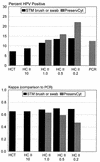Comparison of PCR- and hybrid capture-based human papillomavirus detection systems using multiple cervical specimen collection strategies
- PMID: 9774574
- PMCID: PMC105310
- DOI: 10.1128/JCM.36.11.3248-3254.1998
Comparison of PCR- and hybrid capture-based human papillomavirus detection systems using multiple cervical specimen collection strategies
Erratum in
- J Clin Microbiol 1999 Feb;37(2):478
Abstract
This study compared the performances of three human papillomavirus (HPV) detection tests with specimens collected by three alternative procedures. The HPV tests included the Hybrid Capture Tube test (HCT), the microplate-based Hybrid Capture II test (HC II), and the MY09-MY11 L1 consensus primer PCR-based assay. Initial cervical specimens were collected from study subjects with a broom device, and after Papanicolaou smears were made, residual specimens were placed into PreservCyt (PC), a liquid cytology medium. A second specimen was collected from each subject and placed into Digene Specimen Transport Medium (STM). The device for collection of the second specimen alternated with consecutive subjects between a conical cytology brush and a Dacron swab. At the 1.0-pg/ml cutoff, the results of the HC II agreed well with those of the PCR. Specifically, when PCR data were restricted to the types found by the HC II (HPV types 16, 18, 31, 33, 35, 39, 45, 51, 52, 56, 58, 59, and 68), there was greater than 90% agreement between the HC II and PCR results with both STM and PC. At a lower cutoff (0.2 pg/ml), HC II-positive results increased further, especially when the test was applied to the PC specimens. However, false-positive HC II results were more often observed at the 0.2-pg/ml cutoff. HC II yielded the highest HPV positivity with specimens placed into PC, followed by specimens collected with a conical brush and placed into STM and, last, by those collected with a Dacron swab and placed into STM. Our results demonstrate the utility of both the STM and PC specimen collection methods and show good agreement between the HC II and PCR.
Figures


Similar articles
-
Comparison of the hybrid capture tube test and PCR for detection of human papillomavirus DNA in cervical specimens.J Clin Microbiol. 1997 Sep;35(9):2262-5. doi: 10.1128/jcm.35.9.2262-2265.1997. J Clin Microbiol. 1997. PMID: 9276398 Free PMC article.
-
Stability of PreservCyt for Hybrid Capture (HC II) HPV test.Diagn Cytopathol. 2005 May;32(5):260-3. doi: 10.1002/dc.20232. Diagn Cytopathol. 2005. PMID: 15830373
-
Genital human papillomavirus infection among women recruited for routine cervical cancer screening or for colposcopy determined by Hybrid Capture II and polymerase chain reaction.Diagn Mol Pathol. 1999 Sep;8(3):157-64. doi: 10.1097/00019606-199909000-00009. Diagn Mol Pathol. 1999. PMID: 10565688
-
Detection of human papillomavirus DNA in cervical lavage specimens by a nonisotopic consensus PCR assay.J Clin Microbiol. 1995 Aug;33(8):1973-8. doi: 10.1128/jcm.33.8.1973-1978.1995. J Clin Microbiol. 1995. PMID: 7559932 Free PMC article.
-
[Papillomavirus screening: shall it be performed systematically?].Transfus Clin Biol. 2003 Apr;10(2):86-9. doi: 10.1016/s1246-7820(03)00027-2. Transfus Clin Biol. 2003. PMID: 12763151 Review. French. No abstract available.
Cited by
-
Negative human papillomavirus testing in normal smears selects a population at low risk for developing high-grade cervical lesions.Br J Cancer. 2004 May 4;90(9):1803-8. doi: 10.1038/sj.bjc.6601726. Br J Cancer. 2004. PMID: 15150605 Free PMC article.
-
Human papillomavirus infections in primary care.Clin Med Res. 2007 Dec;5(4):210-7. doi: 10.3121/cmr.2007.751. Epub 2007 Dec 17. Clin Med Res. 2007. PMID: 18086908 Free PMC article. Review.
-
Comparison of real-time multiplex human papillomavirus (HPV) PCR assays with the linear array HPV genotyping PCR assay and influence of DNA extraction method on HPV detection.J Clin Microbiol. 2011 May;49(5):1899-906. doi: 10.1128/JCM.00235-10. Epub 2011 Feb 23. J Clin Microbiol. 2011. PMID: 21346041 Free PMC article.
-
Simultaneous amplification and identification of 25 human papillomavirus types with Templex technology.J Clin Microbiol. 2006 Nov;44(11):4157-62. doi: 10.1128/JCM.01762-06. Epub 2006 Sep 27. J Clin Microbiol. 2006. PMID: 17005760 Free PMC article.
-
Value and feasibility of HPV DNA test in cervical scraping smears.J Huazhong Univ Sci Technolog Med Sci. 2005;25(4):451-3, 467. doi: 10.1007/BF02828221. J Huazhong Univ Sci Technolog Med Sci. 2005. PMID: 16196301
References
-
- Bauer H M, Manos M M. PCR detection of genital human papillomavirus. In: Persing D H, Smith T F, Tenover F C, White T J, editors. Diagnostic molecular microbiology. Washington, D.C: ASM Press; 1993. pp. 407–413.
-
- Bauer H M, Ting Y, Greer C E, Chambers J C, Tashiro C J, Chimera J, Reingold A, Manos M M. Genital human papillomavirus infection in female university students as determined by a PCR-based method. JAMA. 1991;265:472–476. - PubMed
-
- Bernard H U, Chan S Y, Manos M M, Ong C K, Villa L L, Delius H, Peyton C L, Bauer H M, Wheeler C M. Identification and assessment of known and novel human papillomaviruses by polymerase chain reaction amplification, restriction fragment length polymorphisms, nucleotide sequence, and phylogenetic algorithms. J Infect Dis. 1994;170:1077–1085. - PubMed
-
- Bosch F, Manos M M, Muñoz N, Sherman M, Jansen A M, Peto J, Schiffman M H, Moreno V, Kurman R, Shah K V. Prevalence of human papillomavirus in cervical cancer: a worldwide perspective. J Natl Cancer Inst. 1995;87:796–802. - PubMed
Publication types
MeSH terms
Substances
Grants and funding
LinkOut - more resources
Full Text Sources
Medical

